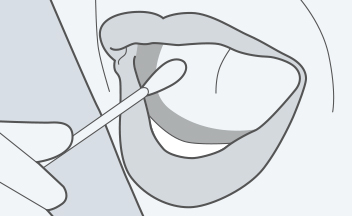Court Approved DNA Test and Immigration DNA Testing
Legal DNA testing is carried out in cases where test participants need their results to stand in a court of law or as evidence of the alleged relationship between individuals in immigration cases. To give a few examples, legal DNA testing is used in cases of alimony and child support or changing the name on a birth certificate. In a legal test, the most integral part is the way samples are collected.
Arranging Your Sampling Appointment
Choose a sampler (a sampler is a third party individual appointed to take your sample). To comply with current legislation, samples must be taken by a health professional. You may either ask your GP or another local doctor. Alternatively, we may be able to suggest a doctor in your area, please contact us for details. Please note that the doctor may charge a fee for taking the DNA sample and this should be negotiated when making an appointment. The doctor’s fee is not included in International Bioscience’s charge.
Once you have arranged an appointment with your chosen doctor, complete and return the registration forms to us, together with your payment, and we will send the DNA testing kit direct to the sampler. You should allow at least seven days for your paperwork to reach us and for the DNA testing kit to reach your chosen doctor.
You will need to take two full-faced, passport-sized photographs of each person to be tested (including children) and current photographic identification (passport or photo driving licence and utility bill) with you to the appointment for identification purposes as well as the doctor’s fee.
*IMPORTANT NOTICE: The sampler may charge you if you fail to keep an appointment without giving notice.
For more information about legal DNA testing, click here.
Collecting Your DNA Sample
The doctor will verify identification and sign the back of the photographs to confirm they are a true likeness of the person to be sampled as follows: “I, doctor’s name, confirm that this photograph is a true likeness of donor’s name”, date, doctor’s signature.
Precautions to Follow
Do not drink coffee or tea, or use tobacco products for 4 hours prior to sampling. Samples containing coffee, tea or tobacco residues may not process properly!
Wash your hands thoroughly and rinse applicant’s mouth three times with warm water. Do not use toothpaste or mouthwash (For infants – allow them to drink water at room temperature from a bottle or wait 2 hours from last feeding).
DNA Test Kit Step by Step Instructions
| STEP 1 | |
 |
Take the first swab inside your DNA test kit, which is to be used to collect the first applicant’s DNA sample. Remove the first swab from its sterile packaging, taking care not to touch the tip of the swab and to retain the envelopes. If you are just one individual carrying out the test, ensure to just use 4 swabs. |
| STEP 2 | |
 |
Fill out the information required on the envelopes used to pack the swabs. Ensure that you clearly complete and sign the details required on the outside of the envelope. Also fill out the consent forms provided in your DNA test kit. Inadequately filled out forms could result in a delay in results so do make sure to do it correctly. Applicants (or their legal guardian) should sign each relevant section as well as their sample collection envelope. |
| STEP 3 | |
 |
Collect cheek cells by rolling the tip of the sample collection swab firmly on the inside of the right cheek (30 times each or for about 1 minute). Be certain to move the swab over the entire inner cheek surface. This action should be firm but not aggressive and should not be uncomfortable. Repeat this process for the same individual with the second swab on the inside of the left cheek. You must submit four swabs per person. |
| STEP 4 | |
 |
Allow the swabs to air dry at room temperature for at least 15 minutes. To avoid contamination, do not allow the tips of the swabs to touch anything. Place the used swabs in the first sample collection envelope (do not put back in plastic packaging). Repeat the procedure for other test participants. |
| STEP 5 | |
 |
Be sure to seal the envelope firmly. Repeat the sample collection process if you are requesting analysis of additional applicants. The completed registration forms and sample collection envelopes should be sealed in the reply envelope provided inside your DNA test kit and returned to us (we recommend Recorded or Special Delivery). |
DNA Test for Immigration
Follow the steps as per the Court Approved DNA Test above.
For immigration cases where one or more applicants currently reside outside Canada, samples must be taken at a Canadian Embassy or an approved clinic in that country. When completing the registration form, please provide a contact name, address and reference number (if applicable) for the relevant embassy. Click here to read more about immigration DNA testing.
